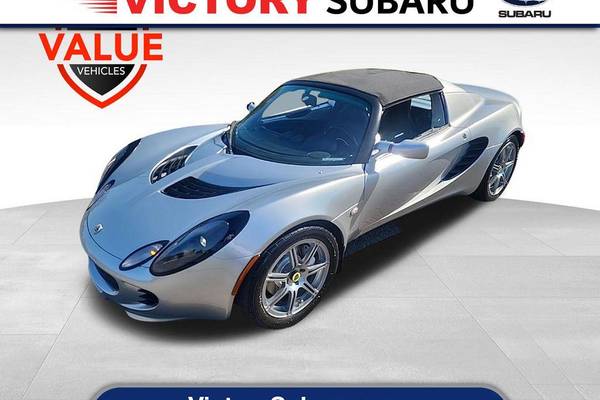2006 Lotus Elise Review
Price Estimate: $4,752 - $6,429
 View 8 more photos
View 8 more photos View 8 more photos
View 8 more photos View 8 more photos
View 8 more photos View 8 more photos
View 8 more photos View 8 more photos
View 8 more photos+4
Edmunds' Expert Review
by the Edmunds Experts
Pros
- Ultralightweight chassis, uninhibited steering, supercar performance without the supercar price, low volume ensures rarity.
Cons
- Spartan interior, difficult entry and exit, peaky power delivery, ride quality more Formula One than grand touring, limited dealer network.
What’s new
Changes for 2006 include an available traction control system, an optional limited-slip differential, lightweight forged alloy wheels, a matte black appearance package and an air conditioning-delete option. Daytime running lights are now standard, along with LED taillights with integrated reflectors. The ProBax seat padding from NuBax has been upgraded for increased comfort and last year's aluminum pedal set has been replaced by a lighter (though now steel) pedal set.
Edmunds says
For those willing to put up with its heavily compromised utility and comfort, the 2006 Lotus Elise provides the most unfiltered driving experience of any roadster sold today.
For sale near Worcester, MA
1 listings
- $51,995
- 45,997 miles
- No accidents, 6 owners, rental vehicle
- Victory Subaru (186 mi away)
- Keyless Entry
- Premium Sound System
- Security System
- Convertible Soft Top
Close
Located in Somerset, NJ
2006 Lotus Elise Artic Silver 4-Wheel Disc Brakes, ABS brakes, Alloy wheels, Blaupunkt AM/FM Stereo w/CD/MP3, Dual front impact airbags, Front Bucket ...
AutoCheck Vehicle History Summary
Accident Free Vehicle: Yes
Personal Use Only: No
History Provider: AutoCheck
Title Details: Clean Title
Salvage Vehicle: No
Frame Damage: No
Theft History: No
Lemon Status: No
Free History Report: No
Features and Specs:
Listing Information:
VIN: SCCPC11116HL31455
Stock: 6HL31455
Certified Pre-Owned: No
Listed since: 01-19-2023
Vehicle overview
One reality, and enemy, of sports car design over the last 30 years has been the inescapable escalation of vehicle weight. While two-seat performance cars have become more comfortable, more reliable and safer in recent decades, they have also become rather portly, at least by sports car standards.
Sadly, if you've wanted both performance and light weight in one machine, you've pretty much had to give up the new-car smell (not to mention modern technology, reliability and safety features) and start shopping the classifieds. But all that ended with the introduction of the Lotus Elise to the U.S. market for 2005. The Elise has been on sale in Europe since 1996, but European demand for the vehicle, along with stringent U.S. crash standards, kept it from leaping the pond -- except for a limited race-only version that wasn't legal to operate on public roads.
The second-generation release of the Elise in 2000 finally gave Lotus the opportunity to plan for a U.S.-certified version. It's true that meeting U.S. crash standards has required the addition of airbags and other safety features that add weight. And Lotus knew that even sports car fans in this country have trouble sacrificing amenities for the sake of performance, so the U.S. Elise comes standard with air conditioning, antilock brakes and an AM/FM/CD audio system. But don't look for stability control or power steering on this sports car. Lotus was willing to bend the Elise's original "weight is the enemy" philosophy for American tastes, but the company refused to break it. The carmaker managed to keep the U.S. Elise's curb weight under the 1-ton mark. At 1,975 pounds, the Elise is easily the lightest performance car sold in this country.
With so little weight to push around, there's not a huge need for power. Therefore, the Lotus Elise has a Yamaha-built, Toyota-badged 1.8-liter, four-cylinder engine. This is the same engine found in the Toyota Corolla XRS, but it's been tuned by Lotus to broaden the power band and bump peak horsepower to 190. That's more than enough power to manage the Elise's increased weight, and Lotus says the car will sprint from zero to 60 mph in under 5 seconds. There's no doubt that the 2006 Lotus Elise is a special car. For the money, you're not going to find a more thrilling driving experience out of a new production car. Just be aware that this is a no-frills, race-oriented machine. Even the Honda S2000, a car we've previously said as being quite minimalist, seems rather posh in comparison. Those wanting a roadster that can provide more day-to-day functionality than the Elise while still providing plenty of driving excitement will want to check out Porsche's Boxster or the aforementioned S2000.
Performance & mpg
Power for the Lotus Elise comes from a Toyota-sourced 1.8-liter, four-cylinder engine mated to a six-speed manual transmission. Lotus fitted unique intake and exhaust components, as well as a reworked engine controller, to broaden the engine's power band and push peak horsepower to 190 at 7,800 rpm. Torque peaks at 138 lb-ft at 6,800 rpm. The four-wheel independent suspension system features Eibach springs and Bilstein monotube shocks. Lotus claims a 0-to-60 time of just 4.9 seconds. A limited-slip differential is optional.
Safety
Don't expect much more than federally mandated safety equipment on the Lotus Elise. A four-wheel antilock brake system is included, but neither stability control nor side airbags are available. A traction control system is optional.
Driving
The non-power steering feels as natural as anything we've ever driven, and the 1.8-liter Toyota engine is indeed more user-friendly (with a far more usable torque curve) than what you'll find in the Corolla XRS or Matrix XRS. Braking is handled by AP Racing two-piston calipers up front and Brembo single-piston calipers in back (11.5-inch rotors all around). This all adds up to a car that feels as race-oriented and capable as a Ferrari 430. When you consider the 2006 Lotus Elise costs roughly one-fourth as much, its true value becomes apparent.
Interior
Interior accommodations relay a clear sports car theme. Composite sport seats provide plenty of support, and controls are simple enough to keep your attention on the road. The wide door sills and low steering wheel require some fancy footwork when entering or exiting the vehicle. Needless to say, the Elise's cockpit emphasizes driving above all else, as there are minimal comfort and storage features for long road trips.
2006 Lotus Elise models
The Lotus Elise is a two-seat, rear-wheel-drive, midengined roadster available in one trim level. The interior is understandably spartan, but must-haves like air conditioning and a CD player are standard (an A/C-delete option is available to save weight). Several option packages offer a bit of customization: The Touring Pack includes leather seating, power windows, an upgraded stereo with MP3 capability, a stowage net, a double-insulated soft top, additional sound-deadening material and full carpeting. The Elise's standard wheel/tire arrangement specifies 16-inch alloys with 175/55R16 Yokohama Advan Neova AD07 tires in front and 17s with 225/45R17 rubber in back. The optional Sport Pack features enhance the car's performance capabilities by swapping out the standard wheels for lightweight alloys, while fitting Yokohama A048 LTS tires (with wider 195/50R16 rubber in front) and a track-tuned suspension. A hardtop is available as a stand-alone option.
Compare 2006 Lotus Elise trim levels
Helpful trims summary and side-by-side comparison chart
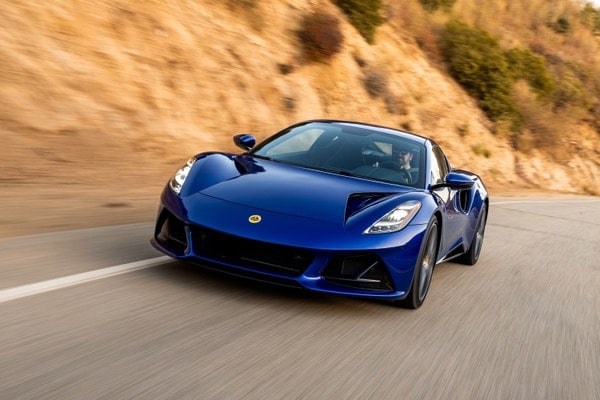
2024 Lotus Emira 2.0 First Drive: New Heart Lacks Soul
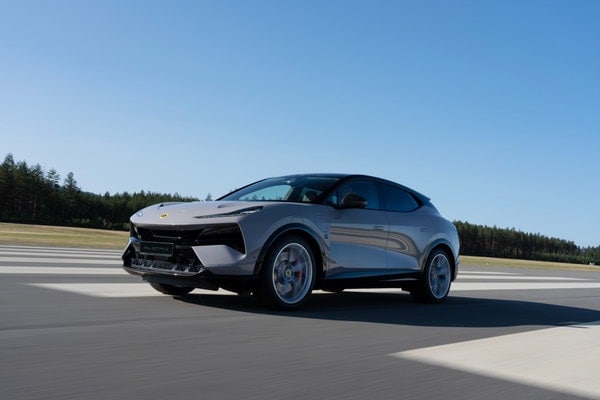
The 2025 Lotus Eletre Is Big, Not Pretty, and Costs Over $100K
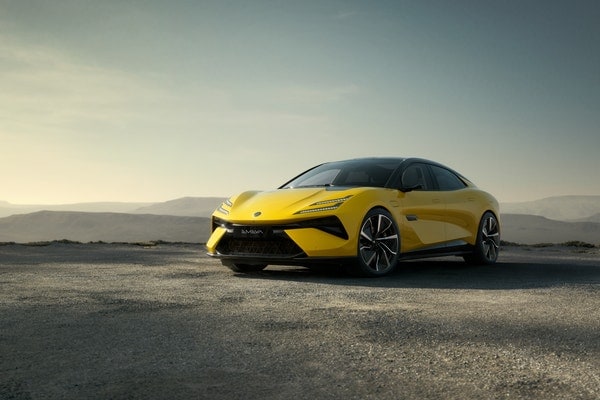
The 2025 Lotus Emeya Is a 905-Horsepower Taycan Pulverizer
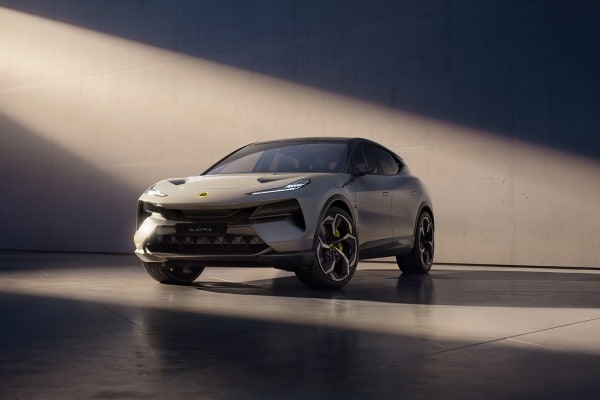
2024 Lotus Eletre Gets a Price, Specs and Three Variants
Cost to Drive
Monthly estimates based on costs in Massachusetts
$223/mo for Elise Base
Elise Base
vs
$166/mo
Avg. Compact Car
Lotus Elise Owner Reviews
Most Helpful Owner Reviews
Trending topics
Best Sports Car!
5 out of 5 starsjhill, 01/21/2007
2006 Lotus Elise 2dr Convertible (1.8L 4cyl 6M)
I have been an owner of five Porsches over the past 14 years. I have driven a 968 convertible, '86 911 Carrera that had a race suspension and performance engine, '98 996 S w/turbo body, '03 997 turbo and a '06 Cayman S. All of these cars were amazing and unique, but the Lotus Elise is truly the ride I have been looking for. Yes it is not a Porsche uni-body design and it does lack … German engineering, but the feed back and handling is so much like a race car it is truly awesome! The light weight chassis design along with the independent suspension makes this vehicle very unique. For the driver that wants a sports car experience, Lotus is as close as you can get to driving a formula one.
Very fun car with some drawbacks
4.5 out of 5 starsIan, 12/04/2008
2006 Lotus Elise 2dr Convertible (1.8L 4cyl 6M)
This car was built for the track. If you buy this car expecting anything more than a driving machine, you are looking at it for the wrong reason. The combination of aluminum and fiberglass that make up the Elise provide a very high power to weight ratio, even with the very small 1.8L Toyota engine. After pushing the car past 6200 rpm you feel a boost in power as the car switches to the … second cam. As you redline in second at 8500 rpm, the shift into third pushes your head back into the seat. At this point you realize that you're on the freeway inching toward 100 and need to slow down. What a killjoy. Amazing handling and road hugging tires make freeway on ramps the best part of your day.
1st Month with My New Lotus Elise
4.88 out of 5 starsBrian , 11/08/2006
2006 Lotus Elise 2dr Convertible (1.8L 4cyl 6M)
This is definitely a car for the person that likes to get noticed, and enjoys performance and handling. I bought a black Elise with a hard top and the neighbors thought I was driving the Batmobile. If you want a car that has a fun factor of 10+, it's a no brainer; however, it is a bit of a challenge to get in and out of, and if you're a large person, or over 60, I'd say, don't even try … to get in and out of it. Braking and acceleration are great. Love the exhaust sound as your driving. Beware, it's an attention getter! For people with large feet, it may pose a challenge to operate pedals, I have to wear certain shoes when I drive as the pedals are close together.
The Ultimate Rush
4.88 out of 5 starsCC, 10/12/2006
2006 Lotus Elise 2dr Convertible (1.8L 4cyl 6M)
This car is amazing, BMW calls their cars the "Ultimate Driving Machines" but this car truly is, no other car comes close. I bought this car to drive to and from the track, and on weekends. After owning a 1986 BMW 3-series track car, two highly modified VW GTI VR6's, a 2000 Audi S4 with over 400hp, and a 2003 Mini cooper S, and I currently own a 2006 Infiniti G35 Coupe as a daily driver, … and I've driven several Porsche 911's, but the Lotus is bar-none the most exciting sportscar I've ever owned. I race shifter karts, and it seems like that's the only type of machine anyone will ever out-handle an Elise in! Plenty quick stock but Forcedfed 275 turbo kit is going in when the warranty runs out.
2006 Elise Highlights
| Base MSRP Excludes Destination Fee | $42,990 |
|---|---|
| Engine Type | Gas |
| Combined MPG | 22 MPG |
| Cost to Drive | $223/month |
| Seating | 2 seats |
| Cargo Capacity All Seats In Place | 4.0 cu.ft. |
| Drivetrain | rear wheel drive |
| Warranty | 3 years / 36,000 miles |
Safety
Key safety features on the Elise include:
- Alarm
Related Used 2006 Lotus Elise info
Vehicle reviews of used models
- Buick Encore GX 2020 Review
- Kia Optima Hybrid 2020 Review
- BMW X7 2020 Review
- Volvo V90 2020 Review
- Ford Fusion Plug In Hybrid 2020 Review
Shop used vehicles in your area
Popular new car reviews and ratings
- 2024 Rolls-Royce Phantom News
- 2025 BMW i7
- 2026 BMW M3 News
- New Chevrolet Silverado 2500HD
- New Nissan LEAF
- New BMW 3 Series
- 2026 BMW 3 Series News
- 2026 Dodge Durango News
- 2024 BMW 4 Series
- Audi S8 2024
Research similar vehicles
Other models
- Used Jaguar XF in Littleton, CO 2024
- New Genesis G70 for Sale in Everett, WA
- Used Volkswagen Golf-Alltrack in Clearfield, UT 2019
- Used Ferrari 430-Scuderia in Fort Washington, MD 2009
- Used Mercedes-Benz Sl-Class in Burnsville, MN 2025
- Used Infiniti QX4 in Egg Harbor Township, NJ 2003
- Used Dodge Grand-Caravan in Highland Park, IL 2020
- Used Ford Mustang-Mach-E in Waldorf, MD 2025
- Used Audi E-Tron-S in Edwardsville, IL 2023
- Used BMW M3-CS in Gary, IN 2024
